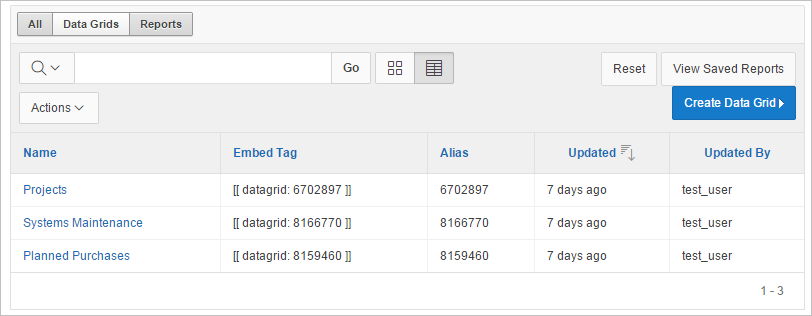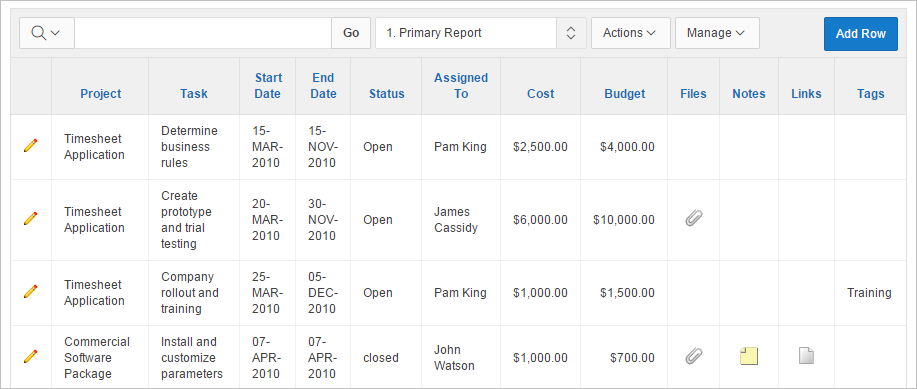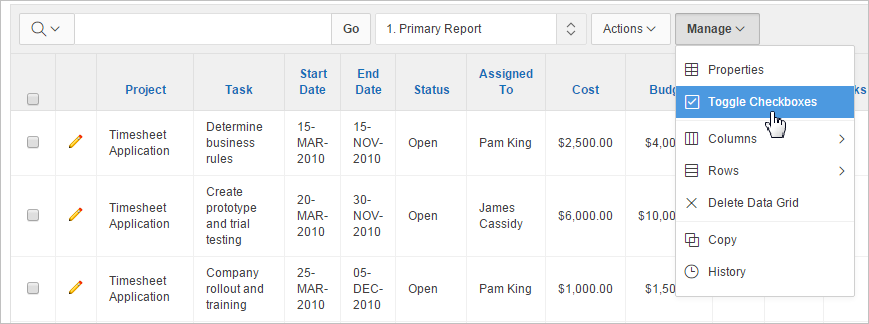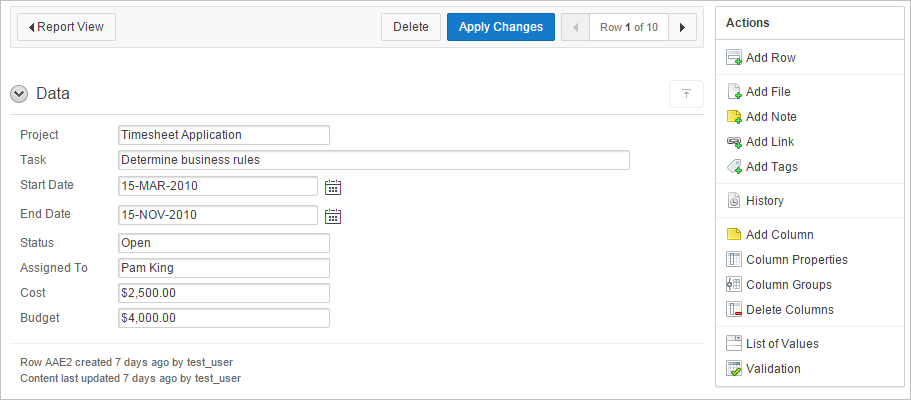5.8 Managing Data Grids
Data grids are sets of data displayed in rows and columns. Data grids store data in a similar way to how spreadsheets store data. Once created, the structure can be modified as needed over time.
- About Data Grids
You can define the structure of a data grid using column names, data sources, and basic validations, or you can create a data grid by pasting spreadsheet data. Once created, the structure can be modified as needed. - Creating a Data Grid
You can create a data grid by either defining the structure (that is, the column names, data sources, and basic validations), or by pasting in spreadsheet data. - Copying a Data Grid
Copy a data grid by clicking Copy in the Manage menu. - Viewing and Editing a Data Grid
Once you create a data grid, you can view and edit it on the Data page. - Viewing the Data Grid Change History Log
View the change history log of a data grid by selecting History in the Manage menu. - Deleting a Data Grid
Delete a data grid by selecting Delete Data Grid in its Manage menu.
Parent topic: Using Websheets
5.8.1 About Data Grids
You can define the structure of a data grid using column names, data sources, and basic validations, or you can create a data grid by pasting spreadsheet data. Once created, the structure can be modified as needed.
You can alter the layout of report data by selecting columns or by applying filters, highlighting, and sorting. You can also define breaks, aggregations, group bys, computations, and different charts.
Additionally, you can create multiple variations of a data grid and save them as named reports, for either public or private viewing. You can also use the data from a data grid and include it as a chart or report within any page.
See Also:
Parent topic: Managing Data Grids
5.8.2 Creating a Data Grid
You can create a data grid by either defining the structure (that is, the column names, data sources, and basic validations), or by pasting in spreadsheet data.
In addition to the defined columns, the following standard columns are always included within each data grid: owner, created by, created on, updated by, updated on, row order, and annotation (files, notes, links, and tags).
- Creating a Data Grid from Scratch
Create a data grid from scratch by clicking New Data Grid in the Create menu and selecting From Scratch. - Creating a Data Grid by Copying and Pasting Spreadsheet Data
Create a data grid by copying and pasting spreadsheet data by clicking New Data Grid in the Create menu and selecting Copy and Paste.
Parent topic: Managing Data Grids
5.8.2.1 Creating a Data Grid from Scratch
Create a data grid from scratch by clicking New Data Grid in the Create menu and selecting From Scratch.
When you create a data grid from scratch you must define the column names, datatypes, and basic values. Once you have created the basic structure, you can then populate it with data.
To create a data grid from scratch:
See Also:
Editing Data Grid DataParent topic: Creating a Data Grid
5.8.2.2 Creating a Data Grid by Copying and Pasting Spreadsheet Data
Create a data grid by copying and pasting spreadsheet data by clicking New Data Grid in the Create menu and selecting Copy and Paste.
To create a data grid by copying and pasting spreadsheet data:
Parent topic: Creating a Data Grid
5.8.3 Copying a Data Grid
Copy a data grid by clicking Copy in the Manage menu.
To copy a data grid:
Parent topic: Managing Data Grids
5.8.4 Viewing and Editing a Data Grid
Once you create a data grid, you can view and edit it on the Data page.
Tip:
Data grids display as an interactive report.
- Accessing the Data Page
Access the Data page by selecting View All in the Data Grid menu. - Toggling Check Boxes
Toggle whether check boxes display when viewing a data grid by selecting Toggle Checkboxes in the Manage menu. - Editing Data Grid Data
Edit the data in a data grid by clicking a valid cell or add a new row by clicking the Add Row button. - Editing Data Grid Columns Manually
Manually edit columns in a data grid by clicking Columns in the Manage menu. - Editing Data Grid Rows Manually
Manually edit rows in a data grid by clicking Rows in the Manage menu. - Editing a Single Data Grid Row
Edit a single row in a data grid by clicking its Edit Row icon (pencil). - Adding Annotations to a Single Data Grid Row
Add annotations to a row in a data grid by clicking its Edit Row icon (pencil). - Displaying Annotation Columns in a Data Grid Report
Choose which columns to display in a data grid by clicking the Actions menu and selecting Select Columns. - Displaying Pseudo Columns in a Data Grid Report
Choose whether to display pseudo columns in a data grid report by clicking the Actions menu and selecting Select Columns, then save the report. - Editing Data Grid Properties
Change the name, alias, and description of a data grid on the Data Grid Properties page. - Creating a Bookmark Link to a Data Grid
Create a bookmark link to a data grid by adding the appropriate syntax to the URL of its parent Websheet or retrieving the URL manually.
Parent topic: Managing Data Grids
5.8.4.1 Accessing the Data Page
Access the Data page by selecting View All in the Data Grid menu.
To access the Data page:
Parent topic: Viewing and Editing a Data Grid
5.8.4.2 Toggling Check Boxes
Toggle whether check boxes display when viewing a data grid by selecting Toggle Checkboxes in the Manage menu.
To display checkboxes adjacent to each row:
Parent topic: Viewing and Editing a Data Grid
5.8.4.3 Editing Data Grid Data
Edit the data in a data grid by clicking a valid cell or add a new row by clicking the Add Row button.
To edit data grid data:
To add another row:
Tip:
You can also edit an entire row by clicking the Edit Row button (pencil) adjacent to the row.Parent topic: Viewing and Editing a Data Grid
5.8.4.4 Editing Data Grid Columns Manually
Manually edit columns in a data grid by clicking Columns in the Manage menu.
To manually edit data grid columns:
Parent topic: Viewing and Editing a Data Grid
5.8.4.5 Editing Data Grid Rows Manually
Manually edit rows in a data grid by clicking Rows in the Manage menu.
To manually edit data grid rows:
Parent topic: Viewing and Editing a Data Grid
5.8.4.6 Editing a Single Data Grid Row
Edit a single row in a data grid by clicking its Edit Row icon (pencil).
To manually edit a single data grid row:
Tip:
You can use the Actions region on the Add/Edit Row page to add a new row, add a file, add annotations, add links, add tags, view a history of changes, add a column, edit column properties and group, delete columns, and create a list of values or a validation.
Parent topic: Viewing and Editing a Data Grid
5.8.4.7 Adding Annotations to a Single Data Grid Row
Add annotations to a row in a data grid by clicking its Edit Row icon (pencil).
To add annotations (that is, files, notes, links, and tags) to a single data grid row:
See Also:
Parent topic: Viewing and Editing a Data Grid
5.8.4.8 Displaying Annotation Columns in a Data Grid Report
Choose which columns to display in a data grid by clicking the Actions menu and selecting Select Columns.
To display annotation columns (such as Files, Notes, Links, and Tags) in a data grid report:
To ensure that all users can see the columns, developers can save the revised layout as the default report.
To save a new default report:
Parent topic: Viewing and Editing a Data Grid
5.8.4.9 Displaying Pseudo Columns in a Data Grid Report
Choose whether to display pseudo columns in a data grid report by clicking the Actions menu and selecting Select Columns, then save the report.
Data grids include the following pseudo columns:
To display pseudo columns in a data grid report:
- Include the pseudo columns in the data grid report:
- View the data grid report.
- Click the Actions menu and then Select Columns.
- In the Select Columns region, move the pseudo columns to Display in Report.
- Click Apply.
- Save a new default report:
Parent topic: Viewing and Editing a Data Grid
5.8.4.10 Editing Data Grid Properties
Change the name, alias, and description of a data grid on the Data Grid Properties page.
To edit data grid properties:
Parent topic: Viewing and Editing a Data Grid
5.8.4.11 Creating a Bookmark Link to a Data Grid
Create a bookmark link to a data grid by adding the appropriate syntax to the URL of its parent Websheet or retrieving the URL manually.
To bookmark directly to a data grid or a row:
To get a link to a specific data grid row:
Parent topic: Viewing and Editing a Data Grid
5.8.5 Viewing the Data Grid Change History Log
View the change history log of a data grid by selecting History in the Manage menu.
The View Change History log displays a report of data grid changes. This report lists the row, column name, old value, new value, user who authored the change, and how long ago the change occurred.
To view a history of data grid changes:
Parent topic: Managing Data Grids
5.8.6 Deleting a Data Grid
Delete a data grid by selecting Delete Data Grid in its Manage menu.
To delete a data grid:
Parent topic: Managing Data Grids



